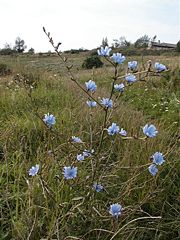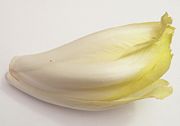Chicory
| Common Chicory | ||||||||||||||||
|---|---|---|---|---|---|---|---|---|---|---|---|---|---|---|---|---|
 Common chicory (Cichorium intybus)
|
||||||||||||||||
| Scientific classification | ||||||||||||||||
|
||||||||||||||||
| Binomial name | ||||||||||||||||
| Cichorium intybus L. |
Common chicory (Cichorium intybus) is a bushy perennial herb with blue, lavender, or occasionally white flowers. It grows as a wild plant on roadsides in its native Europe, and in North America, where it has become naturalized. Common chicory is also known as blue sailors, succory, and coffeeweed. It is also called cornflower, although that name is more properly applied to Centaurea cyanus. The cultivated forms are grown for their leaves (var. foliosum), or for the roots (var. sativum), which are baked, ground, and used as a coffee substitute and additive. Common names for varieties of var. foliosum include endive, radicchio, Belgian endive, French endive, red endive, sugarloaf or witloof.
Chicory is also the common name in the US (and in France) for curly endive (Cichorium endivia). There is considerable confusion between Cichorium endivia and Cichorium intybus. [1][2]
Contents |
Leaf chicory
Chicory may be grown for its leaves, eaten raw as a salad. It is generally divided into three types of which there are many varieties[3]:
- Radicchio usually has variegated red or red and green leaves. Some only refer to the white-veined red leaved type as radicchio. Also known as red endive and red chicory. It has a bitter and spicy taste, which mellows when it is grilled or roasted. It can also be used to add color and zest to salads.
- Sugarloaf looks rather like cos lettuce, with tightly packed leaves.
- Belgian endive is also known as French endive, witlo(o)f in the USA, chicory in the UK, as witlof (the Dutch name) in Australia, endive in France, and chicon in parts of Northern France and in Francophone parts of Belgium. It has a small head of cream-coloured, bitter leaves. It is grown completely underground or indoors in the absence of sunlight in order to prevent the leaves from turning green and opening up (etiolation). The plant has to be kept just below the soil surface as it grows, only showing the very tip of the leaves. It is often sold wrapped in blue paper to protect it from light and so preserve its pale colour and delicate flavour. The smooth, creamy white leaves may be served stuffed, baked, boiled, cut and cooked in a milk sauce, or simply cut raw. Slightly bitter, the whiter the leaf, the less bitter the taste. The harder inner part of the stem, at the bottom of the head, should be cut out before cooking to prevent bitterness. Belgium exports chicon/witloof to over 40 different countries.[4] The technique for growing blanched endives was accidentally discovered in the 1850s in the Josaphat valley in Schaerbeek, Belgium [5]. Endive is cultivated for culinary use by cutting the leaves from the growing plant, then keeping the living stem and root in a dark place. A new bud develops but without sunlight it is white and lacks the bitterness of the sun-exposed foliage. Today France is the largest producer of endives.



Although leaf chicory is often called "endive", true endive (Cichorium endivia) is a different species in the genus.
Root chicory
Root chicory (Cichorium intybus var. sativum) has been in cultivation in Europe as a coffee substitute for a long time. The roots are baked, ground, and used as a coffee substitute and additive, especially in the Mediterranean region (where the plant is native), although its use as a coffee additive is also very popular in India, parts of Southeast Asia and the American South, particularly in New Orleans.
Around 1970 it was found that the root contains up to 20% inulin, a polysaccharide similar to starch. Since then, new strains have been created, giving root chicory an inulin content comparable to that of sugar beet (around 600 dt/ha). Inulin is mainly found in the plant family Asteraceae as a storage carbohydrate (for example Jerusalem artichoke, dahlia etc.). It is used as a sweetener in the food industry (with a sweetening power 30% higher than that of sucrose) and is sometimes added to yogurts as a prebiotic. Inulin can be converted to fructose and glucose through hydrolysis. Inulin is also gaining popularity as a source of soluble dietary fibre.
Chicory, with sugar beet and rye was used as an ingredient of the East German Mischkaffee (mixed coffee), introduced during the "coffee crisis" of 1976-9.
Some beer brewers use roasted chicory to add flavor to their stouts.
Herbal use
Chicory (especially the flower) was used as a treatment in Germany, and is recorded in many books as an ancient German treatment for everyday ailments. It is variously used as a tonic and appetite stimulant, and as a treatment for gallstones, gastro-enteritis, sinus problems and cuts and bruises. (Howard M. 1987)
Use and toxicity
According to traditional folklore, long-term use of chicory as a coffee substitute may damage human retinal tissue, with dimming of vision over time and other long term effects.[6] Modern scientific literature contains little or no evidence to support or refute this claim. Ophthalmologists at the University of Minnesota say that a condition that causes permanent vision loss has been diagnosed in a small group of men who have ingested large amounts of chicory. The condition, nonarteritic ischemic optic neuropathy (NAION), described as "stroke of the eye," occurs when blood flow is cut off to the optic nerve, which injures the nerve and results in permanent vision loss. These cases were published in the March 2005 issue of the Journal of Neuro-ophthalmology.
Root chicory contains volatile oils similar to those found in plants in the related genus Tanacetum which includes Tansy, and is likewise effective at eliminating intestinal worms. All parts of the plant contain these volatile oils, with the majority of the toxic components concentrated in the plant's root. [7]
Chicory is well known for its toxicity to internal parasites. Studies indicate that ingestion of chicory by farm animals results in reduction of worm burdens,[8] [9] [10] which has prompted its widespread use as a forage supplement. There are only a few major companies active in research, development, and production of chicory varieties and selections. Most of them are in New Zealand.
History
The chicory plant is one of the earliest cited in recorded literature. Horace mentions it in reference to his own diet, which he describes as very simple: "Me pascunt olivae, me cichorea, me malvae" ("As for me, olives, endives, and mallows provide sustenance").[11] Lord Monboddo describes the plant in 1779[12] as the "chicoree", which the French cultivate as a pot herb. In the Napoleonic Era in France, chicory frequently appeared as either an adulterant in coffee or a coffee substitute; this practice also became common in the United States and the United Kingdom, e.g., in England during the Second World War and in Camp Coffee, a coffee and chicory essence which has been on sale since 1885.
In the United States chicory root has long been used as a substitute for coffee in prisons.[13]
Chicory is an ingredient in typical Roman recipes, generally fried with garlic and red pepper, with its bitter and spicy taste, often together with meat or potatoes. FAO reports that in 2005, China and the USA were the top producers of lettuce and chicory.
Chicory is also mentioned in certain sericulture (silk-growing) texts. It is said that the primary caretaker of the silkworms, the "silkworm mother" should not eat or even touch it.
The chicory flower is often seen as inspiration for the Romantic concept of the Blue Flower. It was also believed to be able to open locked doors, according to European folklore.[14]
Production
FAO reports that world production of lettuce and chicory for calendar year 2007 is 23.55 million metric tonnes, primarily coming from China(51%), United States(22%) and Spain(5%).
| Top Ten Lettuce and Chicory Producers — 2007 | ||||
|---|---|---|---|---|
| Country | Production (Tonnes) | Footnote | ||
| 12000000 | F | |||
| 5105980 | ||||
| 1070000 | F | |||
| 850078 | ||||
| 790000 | F | |||
| 560000 | F | |||
| 471000 | F | |||
| 382034 | ||||
| 275000 | F | |||
| 185000 | F | |||
| 23550943 | A | |||
| No symbol = official figure, P = official figure, F = FAO estimate, * = Unofficial/Semi-official/mirror data, C = Calculated figure A = Aggregate(may include official, semi-official or estimates); |
||||
References
- ↑ http://www.innvista.com/HEALTH/foods/vegetables/chicory.htm
- ↑ http://plantanswers.tamu.edu/vegetables/endive.html
- ↑ http://www.gardenzone.info/crops/index.php?crop=chicory
- ↑ 'Jeannie Bastian'. It Ain’t Chicken. Accessed November 15 2006.
- ↑ http://www.foodmuseum.com/endive.html
- ↑ A Modern Herbal. 1931fs. ISBN 0486227987 & 0486227995.
- ↑ Edible and Medicinal Plants of the West, Gregory L. Tilford, ISBN 0-87842-359-1
- ↑ "Individual administration of three tanniferous forage plants to lambs artificially infected with Haemonchus contortus and Cooperia curticei.". Vet Parasitol. 146 (1-2): 123–34. 2007-05-15. PMID : 17336459.
- ↑ "The use of chicory for parasite control in organic ewes and their lambs.". Parasitology. 134 (Pt 2): 299–307. February 2007. PMID : 17032469.
- ↑ "The effect of chicory ( Cichorium intybus ) and sulla ( Hedysarum coronarium ) on larval development and mucosal cell responses of growing lambs challenged with Teladorsagia circumcincta.". Parasitology. 132 (Pt 3): 419–26. March 2006. PMID : 16332288.
- ↑ Horace, Odes 31, ver 15, ca 30 BC
- ↑ Letter from Monboddo to John Hope, 29 April, 1779; reprinted by William Knight 1900 ISBN 1-85506-207-0
- ↑ (a) Delaney, John H. "New York (State). Dept. of Efficiency and Economy Annual Report". Albany New York, 1915, p. 673. Accessed via Google Books.
(b) "Prison Talk" website; Kentucky section: http://www.prisontalk.com/forums/archive/index.php/t-173368.html. - ↑ Howard, Michael. Traditional Folk Remedies (Century, 1987), p.120.
See also
External links
- Herb Teas and old remedies : Chicory (fr.with translator)
- Chicory Coffee - How Does it Taste?
- ITIS 36762
- Chicory, endive, and other gourmet greens
- Chicory photo and description
- Dogfish Head's Chicory Stout
- History of Belgian Endive (link not working august 2008
- History of Belgian Endive
- Species of chicory and endive